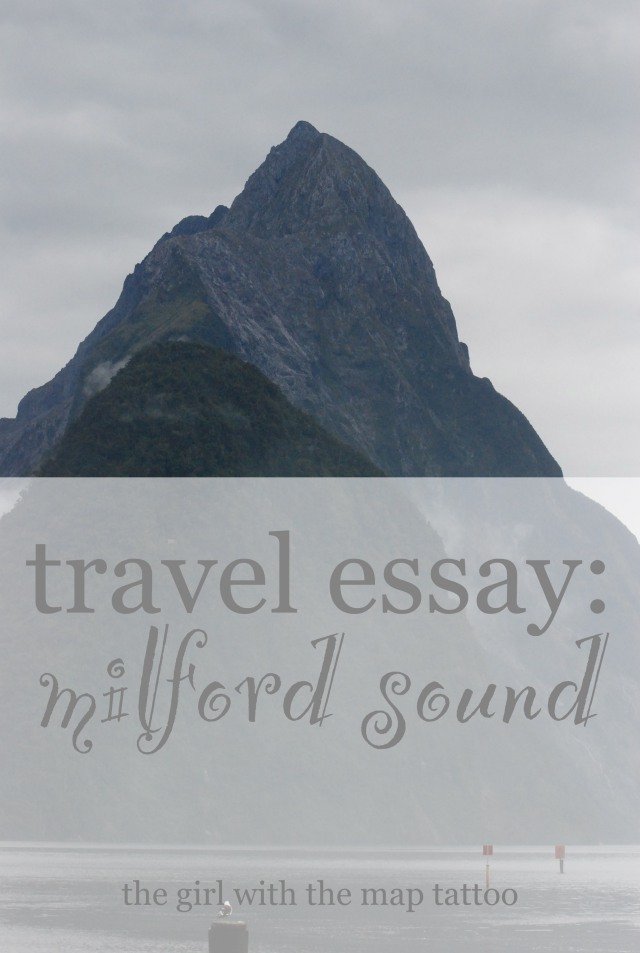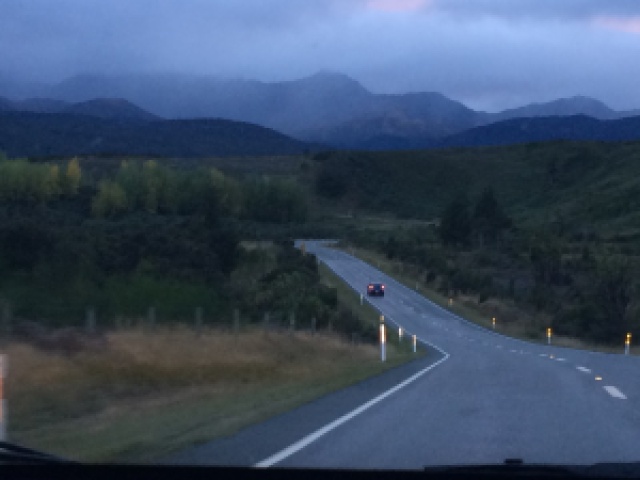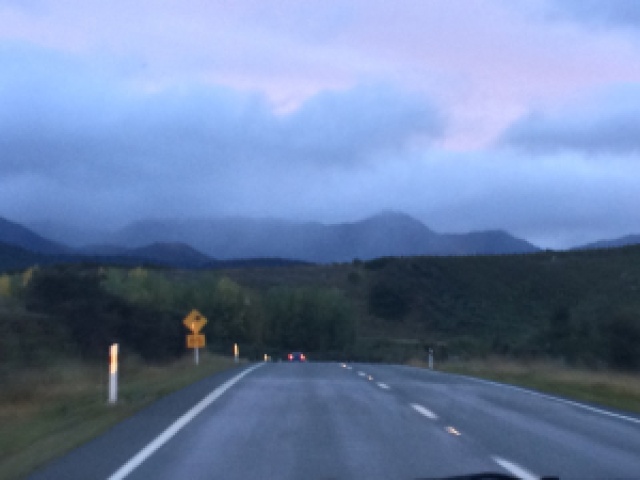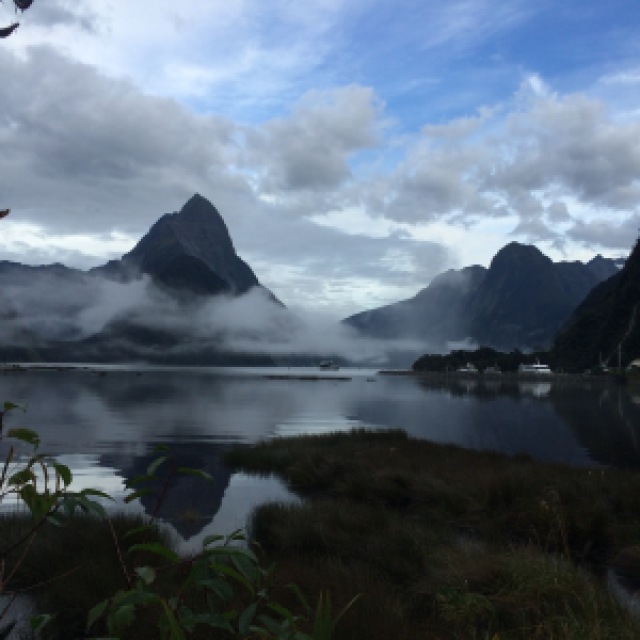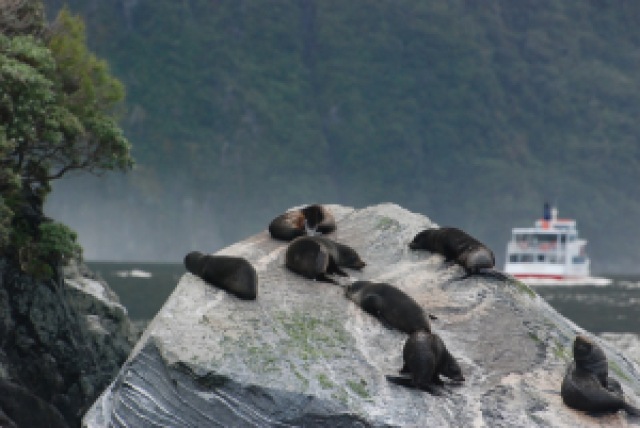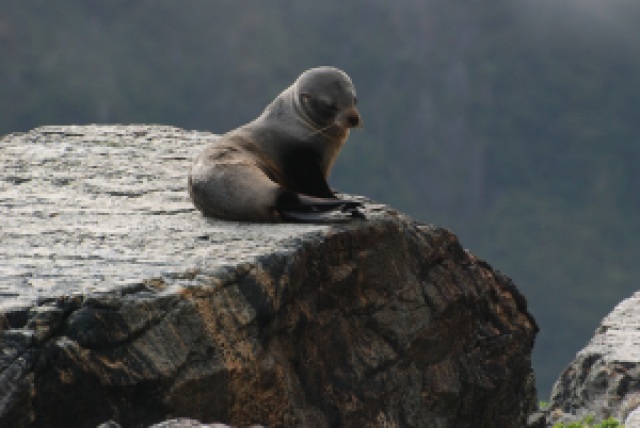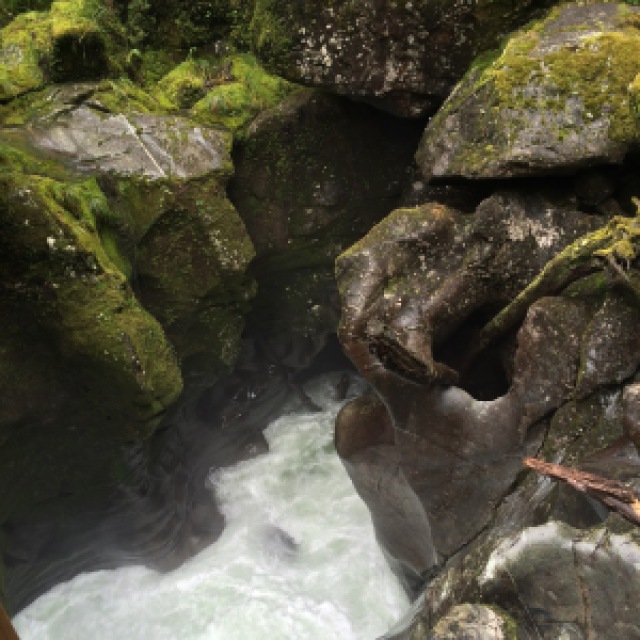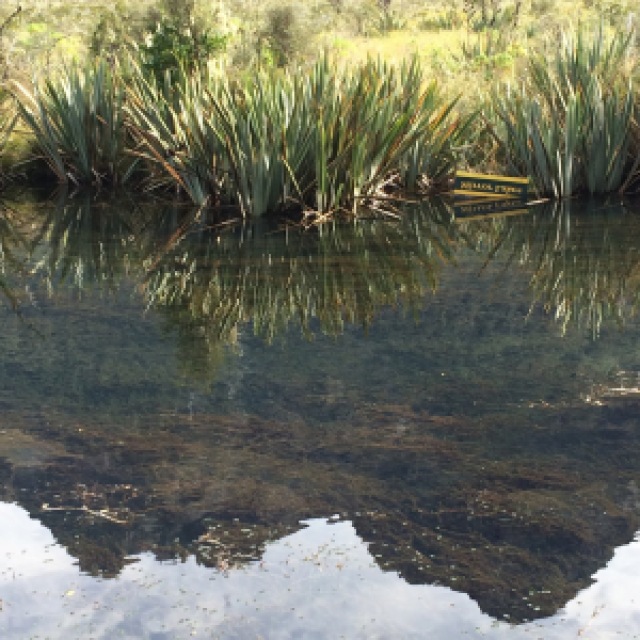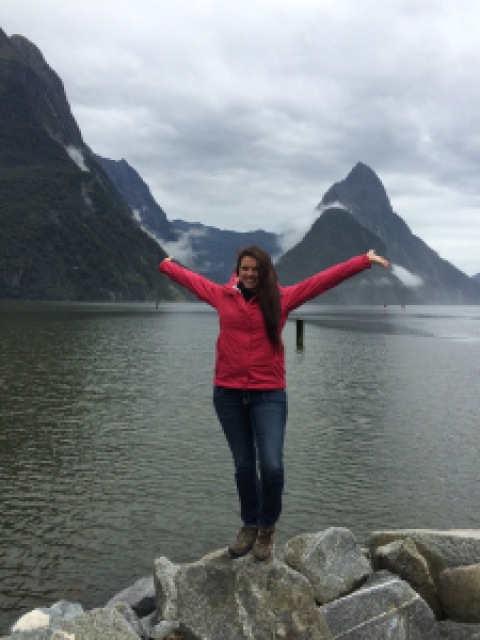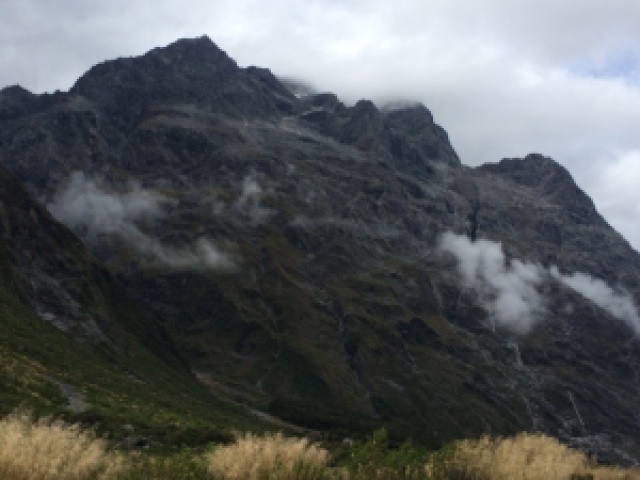To my right, the sun tries hard to peek through the heavy clouds. Crimsons, salmon, magenta, and gold fight for space with the grey early morning. To my left, a dense fog sits over Lake Te Anau, obscuring the mountains across the way. We speed along the lake, the roads curving seductively through the alpine forest. Spruce trees tower above us. As we come over the hill into Te Anau Downs, there are four girls sitting by the side of the road with their luggage piled around them. Their car sits in the ditch. No one can stop immediately, nor do we have mobile service. The lead car – a semi truck – pulls over about a kilometre away.
Dad keeps driving. The road leaves the lake shore now, heading inland toward the Eglington Valley. We don’t plan to stop this morning, but we make a note of where everything is so we can stop on the way back. The Mirror Lakes are suddenly in front of us, hidden from the road by a thin grove of trees. They mark the start of Knobs Flats and once we are out of there we begin to climb.
Soon, we near the Hollyford Valley, which is now far below us. A river rushes through the dense trees. We climb high, looking out at the peaks of the Darren Mountains across the valley floor. And then, we descend – just a bit. The river is now alongside us, a narrow mountain stream overflowing with the recent rains. Boulders – enormous rounded boulders – sit in the stream, shaped by time and water, remnants of another era. They don’t impede the water; rather, the water and the boulders are one. The water is clear; even in a car flying past at 80kms I can see the bottom. The mountain peaks seem further away, even though we have been steadily ascending. The valley floor falls away below us, fading to a dark shade of green rather than recognisable trees.
Ahead of us is the Homer Tunnel. In 1889, William Homer found the Homer Saddle and suggested that the tunnel be built, as it would raise tourism into the Milford Sound area. How right he was. A tunnel was design in the 1930s and completed by the late 1950s. It’s early, and we haven’t seen very many cars, but in Te Anau and Queenstown, there are plenty of people waking early each day to make their way to the Sound for a day trip. It’s one of the top destinations in New Zealand, let alone the world, and considered a wonder of the natural world. The eastern portal of the Homer Tunnel is the highest point along the Milford-Te Anau road, at 945 m high; it descends at a 1:10 gradient to the western portal.
We have a green light upon entering the tunnel – it’s one lane in the summers- and we creep forward in the dim light. Whitewash lines the lower half and a thin strip of lights illuminates the curved ceiling. It takes us at least three minutes to transit the tunnel and at the end we cross a small bridge before returning to the road. It’s an expanse that would take years to acclimate to. The view is stunning, even in the fog.
Mountains surround us wholly. The road is invisible down below and fog obscures the tops of the peaks: we are alone, at peace, at one, with nature here. There is no sound except for hushed “wow”s — it is stunning, indescribable. I later ask people in town to describe it for me: “awesome,” “phenomenal,” “paradise found,” “awesome,” “breathtaking,” “jaw-dropping,” “dope as,” … “unexperienced.”
(That last one is Zander, the bartender at a restaurant in Te Anau – he’s been here two months and hasn’t done it yet. I know the feeling: I haven’t been to Cape Reinga yet.)
We cruise silently to the Cleddau Valley floor, and once again are surrounded by fog and dark, peaceful forest. All of a sudden, we see signs of life. The Milford Sound Lodge appears to our left and so do some hitchhikers. Then it’s the parking lots. We park and make our way along the boardwalk to the cruise terminal. The sun begins to peek out and blue sky starts to win the battle over the grey.
Side note: I feel like someone is missing out on an opportunity here: there was no coffee in the terminal building! I asked and was told I could go to the cafe out by the car park but I didn’t have enough time (“ten minutes each way,” my ass. Four minutes.) so I didn’t go. I repeat: I suffered through a morning without coffee.
Our cruise boards right on time. We had opted for Mitre Peak cruises – a small boat operator – rather than one of the larger tours. There are around 30 people on board with us and everyone spreads out between the top deck, inside, and the bow. Our captain, Graeme, takes us around to the fishing fleet before turning around and cruising out along the southern shore. We pass waterfalls, rocky points with fur seals, and all the while I am awed by the sheer size and scale of the soaring mountains around me. We duck out into the Tasman Sea; the boat begins to rock and roll as we encounter swells. We won’t make it to the lighthouse, Graeme says, but I can now say I’ve been on a boat in all but one major body of water (Indian Ocean.)
As we make a quick turn, we roll slightly with the swell. The entrance to Milford Sound has disappeared behind us; this is partially the reason that Captain Cook was not the one to discover this famed Sound (although true to his pessimistic nature, he did found Doubtful Sound.) Instead, a Welshman named John Grono discovered it. (Alright, Maori have always known about Piopiotahi; technically speaking Grono was the first European to find it.)
Our journey back to the terminal is along the northern shore. We come across Seal Point, aptly named as seals lounge on the angular rock, their flippers tucked under their furry bodies. One begins to play King of the Rock, his mates attempting to gain entrance to the coveted high seat; he has none of it though and one slithers into the water at our feet. We get very close, our engine purring, but it doesn’t seem to bother them.
I make friends with a young boy on our boat, Sam, from California. We banter back and forth while his parents take photos and while Sam badgers his mom to let him use her phone for some photos. Sam spots a seal in the water with a fish – and I snap a photo. I promise Sam I’ll post it here… so here it is.
Sam also makes friends with Cam, the deckhand, and we learn a little bit more about Milford Sound. As Graeme pilots us into a waterfall, Sam and I pull our hoods up around our faces and let the spray shower us… rumour has it I’ll look ten years younger, but maybe I’m mistaking my fairy tales.
All too soon, we are back at the terminal and shuttled off the boat. I wander out to get some more pictures while Sam checks out the wheelhouse; I run into them one last time and we exchange the sort of pleasantries one exchanges with a fellow traveller that you know you’ll never seen again: “safe travels,” “enjoy your trip,” etc. I sincerely hope they do… and I hope Sam remembers this incredible landscape and can instantly transport himself back here with his words. I sense he’s an inquisitive soul like me.
On our drive back to Te Anau, we stop at the Chasm, where the Cleddau River crashes through the mountain, gradually shaping the rocks into cheese-like holes. We get caught at the Homer Tunnel entrance. I’ve got seven minutes, so I hop out of the car and snap a few shots of the road below me. Mom and Dad tell me to be careful – as if I need the reminder that I’m standing in a remote part of the world. I feel like I’m standing on top of the world: the clouds have lifted, the sun shines brightly in the valley and the sheer mountains drop away from where I stand.
It’s an ancient valley. The pines stand tall, the rocks solid. Soon, we’re given the go ahead for the tunnel and we cross the bridge into the tunnel. It’s essentially a hole in the mountain. There is a thin strip of lights but it’s not fancy, not like other mountain tunnels. Not concrete and steel, not man-made. Just… a hole in the mountain.
We come out the other side and are at the highest point again. From here, we will only go downhill. The views across the Hollyford Valley are surreal. My mom says later that she wasn’t not prepared to be so impressed. Pictures cannot do it justice.
We stop a few times on the way back. There’s a viewpoint with views back across the Cleddau River that wends through the valley. There’s the Eglington Flats and Valley, where we stop for the Mirror Lakes. Apparently this is better at dawn, but since our dawn was grey and harsh, we stop later in the afternoon when the sun isn’t as strong, the reflections not as crystal… but it is still unique. The mountains across the flats still shimmer in the tiny wake made by the lone duck and the cheeky sign still looks like it belongs at a summer camp from another era.
We begin to see more signs of life. We cross into Te Anau Downs, where the sheep farmers are about in their Utes with farm dogs hanging out the back, their tongues wagging in the unexpected warm afternoon. We pass the site of the morning’s accident, no trace of it left. The lake appears on our right and the deep set pines that I remember from the early dawn, now a dark vivid green in the afternoon sun.
As we enter town, I’m left with just words to describe my morning. Pictures will never be able to show off the intensity of the mountains, the way that they rise majestically out of the ocean. The way the clouds drape over the hills as if they’re long lost friends reunited. The way the Hollyford Valley appears from nowhere and how the Cleddau River is an ice blue seam in a blanket of green.
Like this post? Pin it!
